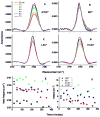Using infrared spectroscopy of cyanylated cysteine to map the membrane binding structure and orientation of the hybrid antimicrobial peptide CM15
- PMID: 22103476
- PMCID: PMC3246368
- DOI: 10.1021/bi200903p
Using infrared spectroscopy of cyanylated cysteine to map the membrane binding structure and orientation of the hybrid antimicrobial peptide CM15
Abstract
The synthetic antimicrobial peptide CM15, a hybrid of N-terminal sequences from cecropin and melittin peptides, has been shown to be extremely potent. Its mechanism of action has been thought to involve pore formation based on prior site-directed spin labeling studies. This study examines four single-site β-thiocyanatoalanine variants of CM15 in which the artificial amino acid side chain acts as a vibrational reporter of its local environment through the frequency and line shape of the unique CN stretching band in the infrared spectrum. Circular dichroism experiments indicate that the placements of the artificial side chain have only small perturbative effects on the membrane-bound secondary structure of the CM15 peptide. All variant peptides were placed in buffer solution, in contact with dodecylphosphatidylcholine micelles, and in contact with vesicles formed from Escherichia coli polar lipid extract. At each site, the CN stretching band reports a different behavior. Time-dependent attenuated total reflectance infrared spectra were also collected for each variant as it was allowed to remodel the E. coli lipid vesicles. The results of these experiments agree with the previously proposed formation of toroidal pores, in which each peptide finds itself in an increasingly homogeneous and curved local environment without apparent peptide-peptide interactions. This work also demonstrates the excellent sensitivity of the SCN stretching vibration to small changes in the peptide-lipid interfacial structure.
Figures






Similar articles
-
Membrane insertion and bilayer perturbation by antimicrobial peptide CM15.Biophys J. 2007 Sep 1;93(5):1651-60. doi: 10.1529/biophysj.107.104034. Epub 2007 May 11. Biophys J. 2007. PMID: 17496013 Free PMC article.
-
Monitoring structural transitions in IDPs by vibrational spectroscopy of cyanylated cysteine.Methods Mol Biol. 2012;895:245-70. doi: 10.1007/978-1-61779-927-3_17. Methods Mol Biol. 2012. PMID: 22760324
-
Cyanylated Cysteine: A Covalently Attached Vibrational Probe of Protein-Lipid Contacts.J Phys Chem Lett. 2010 Mar 4;1(5):850-855. doi: 10.1021/jz1000177. Epub 2010 Feb 12. J Phys Chem Lett. 2010. PMID: 20228945 Free PMC article.
-
Lipid-induced conformation and lipid-binding properties of cytolytic and antimicrobial peptides: determination and biological specificity.Biochim Biophys Acta. 1999 Dec 15;1462(1-2):89-108. doi: 10.1016/s0005-2736(99)00202-3. Biochim Biophys Acta. 1999. PMID: 10590304 Review.
-
Computer simulation of antimicrobial peptides.Curr Med Chem. 2007;14(26):2789-98. doi: 10.2174/092986707782360105. Curr Med Chem. 2007. PMID: 18045125 Review.
Cited by
-
A strongly absorbing class of non-natural labels for probing protein electrostatics and solvation with FTIR and 2D IR spectroscopies.J Phys Chem B. 2013 May 2;117(17):5009-18. doi: 10.1021/jp402946c. Epub 2013 Apr 15. J Phys Chem B. 2013. PMID: 23537223 Free PMC article.
-
Site-specific infrared probes of proteins.Annu Rev Phys Chem. 2015 Apr;66:357-77. doi: 10.1146/annurev-physchem-040214-121802. Epub 2015 Jan 12. Annu Rev Phys Chem. 2015. PMID: 25580624 Free PMC article. Review.
-
Site-Specific Interrogation of Protein Structure and Stability.Methods Mol Biol. 2022;2376:65-87. doi: 10.1007/978-1-0716-1716-8_3. Methods Mol Biol. 2022. PMID: 34845603
-
Cyanylated Cysteine Reports Site-Specific Changes at Protein-Protein-Binding Interfaces Without Perturbation.Biochemistry. 2018 Jul 3;57(26):3702-3712. doi: 10.1021/acs.biochem.8b00283. Epub 2018 Jun 5. Biochemistry. 2018. PMID: 29787228 Free PMC article.
-
General strategy for the bioorthogonal incorporation of strongly absorbing, solvation-sensitive infrared probes into proteins.J Phys Chem B. 2014 Jul 17;118(28):7946-53. doi: 10.1021/jp5008279. Epub 2014 May 7. J Phys Chem B. 2014. PMID: 24749542 Free PMC article.
References
-
- Caffrey M. Crystallizing Membrane Proteins for Structure Determination: Use of Lipidic Mesophases. Ann Rev Biophys. 2009;38:29–51. - PubMed
-
- Klug CS, Feix JB. Biophysical Tools for Biologists: Vol 1 in Vitro Techniques. Elsevier Academic Press Inc; San Diego: 2008. Methods and applications of site-directed spin Labeling EPR Spectroscopy; pp. 617–658. - PubMed
-
- Langen R, Oh KJ, Cascio D, Hubbell WL. Crystal structures of spin labeled T4 lysozyme mutants: Implications for the interpretation of EPR spectra in terms of structure. Biochemistry. 2000;39:8396–8405. - PubMed
-
- Melo M, Ferre R, Castanho M. Antimicrobial peptides: linking partition, activity and high membrane-bound concentrations. Nat Rev Microbiol. 2009;7:245–250. - PubMed
Publication types
MeSH terms
Substances
Grants and funding
LinkOut - more resources
Full Text Sources

